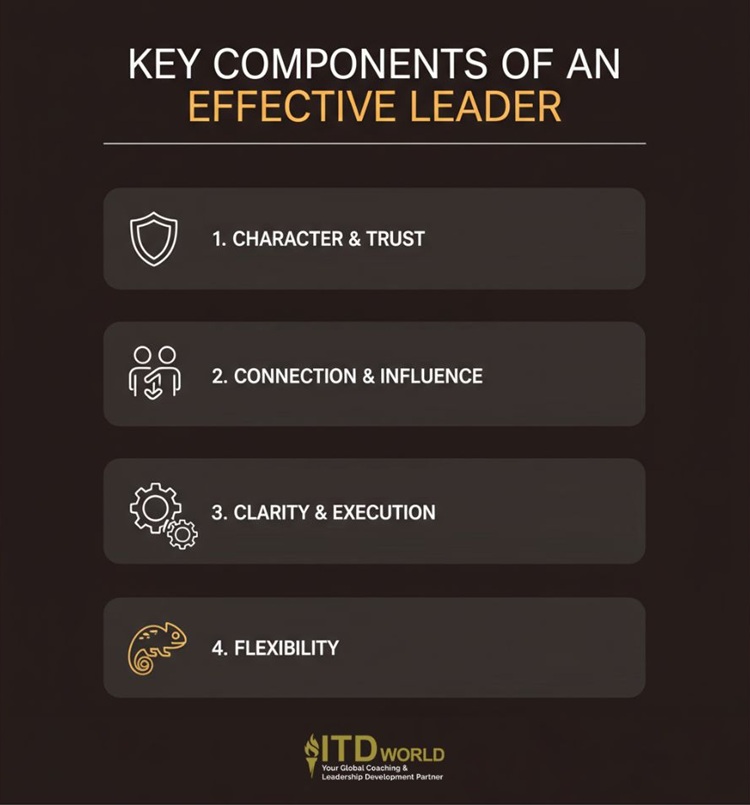A practical guide to leadership effectiveness, how to measure it, core pillars of a good leader, plus a clear path to improvement.
In any organization, many people hold leadership positions, but only a select few are truly performing. The difference is not defined by title or tenure, but by the tangible impact one has on their team and business. Leadership effectiveness is the crucial bridge between a leader’s daily actions and the organization’s most important outcomes – from performance and profitability to engagement and agility. It is a measurable capability that separates leaders who simply manage from those who genuinely multiply their team’s potential.
|
Author: Jonathan M. Pham |
Highlights
- Leadership effectiveness is the demonstrable ability of a leader to positively influence individuals and teams to consistently achieve desired goals while fostering a healthy, high-performing environment, characterized by the right competencies and actions applied adaptably to a given situation.
- Prioritizing leadership effectiveness is a strategic imperative as it directly counters the substantial costs of weak leadership, such as employee disengagement and lost productivity, while simultaneously driving increased profitability, engagement, adaptability, and the development of a strong talent pipeline.
- Great leaders are characterized by a balanced combination of strong character and trust (integrity, accountability, transparency), powerful connection and influence (emotional intelligence, empathy, inspirational communication), and sharp clarity and execution skills (strategic thinking, decisiveness, empowering delegation), all applied with crucial adaptability to different situations.
- Measuring leadership effectiveness requires establishing a competency framework, gathering data from business outcomes, leadership behaviors (via 360-degree feedback), and team health (through engagement surveys and turnover rates), then analyzing these interconnected data points to inform targeted development and improvement.
- Improving leadership effectiveness requires a dual commitment: individual leaders must actively seek feedback, reflect on their actions, and cultivate a personal “board of directors,” while organizations must establish unified frameworks, link effectiveness to career progression, and provide targeted, data-driven training.
What is Leadership Effectiveness?
At its core, leadership effectiveness is the demonstrable ability of a leader to positively influence individuals and teams to consistently achieve desired goals while fostering a healthy, high-performing environment. It is not a measure of seniority, popularity, or even how busy a leader appears to be. Rather, it is judged by its outcomes: the performance, growth, and well-being of the team and the successful attainment of shared objectives. It is the crucial quality that turns a leader’s intent into tangible, positive impact.
All in all, effectiveness can be conceptualized with a simple formula:
Effective Leadership = The Right Competencies x The Right Actions in a Given Situation
The above-mentioned equation highlights three critical elements:
- The Right Competencies: An effective leader possesses a core set of skills and character traits, such as strategic thinking, emotional intelligence, and integrity.
- The Right Actions: They know how to apply these competencies through specific, high-leverage actions, like communicating with clarity, delegating with trust, and providing constructive feedback.
- In a Given Situation: The most effective leaders are adaptable. They understand that what works in a crisis may not during a period of stable growth; hence, they adjust their approach to meet the unique needs of their team and the challenge at hand.
Imagine two leaders are tasked with launching a new product. The first one is active but ineffective. They schedule back-to-back meetings, send a constant stream of emails, and closely manage every task. The team is busy, but also confused about priorities and hesitant to take initiative without approval. They may hit the launch date, but the team is exhausted and disengaged. There was a great deal of activity, but little empowerment or clarity.
The second one begins by clearly defining the goal and ensuring every team member understands their role and the “why” behind the project. They empower their team with autonomy and trust, acting as a coach who removes roadblocks rather than a director who dictates tasks. They hold fewer meetings; however, each one results in alignment and momentum. The team not only launches a successful product but also feels a deep sense of ownership and accomplishment. This is the essence of effectiveness: achieving outstanding results through the team, not in spite of it.

Examples of leadership effectiveness in organizational behavior
The Importance of Leadership Effectiveness in the Workplace
Pursuing leadership effectiveness is more than a matter of improving workplace culture; it is a strategic imperative with a significant and measurable impact on an organization’s bottom line.
The most immediate way to understand the importance of effectiveness is to look at the staggering cost of its absence. Weak leadership is a primary driver of employee disengagement, which creates a massive drain on productivity and profitability. According to Gallup’s research, low employee engagement – heavily influenced by poor management – costs the global economy an estimated $8.8 trillion each year. More than just a theoretical number, it represents lost innovation, higher employee turnover, and a fundamental failure to unlock the human potential.
Conversely, organizations that successfully cultivate effective leadership reap dramatic and compounding rewards. The return on investment is clear across multiple domains:
- Higher productivity and profitability
Effective leaders are adept at creating clarity and motivating teams, which translates directly to financial performance. Research by McKinsey & Company has shown that companies with top-quartile leadership effectiveness post significantly higher total shareholder returns than their peers.
- Increased engagement and well-being
The link between a leader and their people’s performance is undeniable. Gallup research consistently finds that the manager alone accounts for up to 70% of the variance in team engagement. Highly engaged teams, in turn, are more productive, have lower absenteeism, and are generally more loyal to the organization, significantly reducing costly employee turnover.
- Greater agility and adaptability to change
In a volatile market, the ability to pivot is crucial. As noted in the Harvard Business Review, effective leaders who foster resilience and empower their teams are better equipped to navigate disruption. These leaders create an environment of psychological safety where new ideas can be tested, enabling the organization to adapt to challenges and seize opportunities more quickly than its competitors.
- A stronger succession pipeline
Effective leaders don’t just lead; they build future leaders. According to research from DDI, one of the key differentiators of effective leaders is their ability to coach and develop their direct reports. This practice ensures business continuity and builds a robust pipeline of internal talent ready to step into critical roles, reducing external hiring costs and preserving institutional knowledge.
Read more: Talent Development Playbook – Building Your Future Workforce

Key Components of an Effective Leader
Leadership effectiveness is not the result of a single skill or personality trait. It is a balanced combination of who a leader is, how they connect with others, and their ability to drive results.
-
Character & trust (the foundation)
The first pillar is the non-negotiable bedrock upon which all effectiveness is built. Without a strong character, a leader’s skills and intelligence will only produce a hollow impact.
- Integrity & accountability: A steadfast commitment to ethical principles and a willingness to take ownership of outcomes—both good and bad.
Example: When a project misses its deadline, an effective leader doesn’t blame their team or external factors. They step forward and say, “I am accountable for this outcome. Here is what I learned from this setback, and here is our revised plan to move forward.” Such an atttidue plays a crucial role in cultivating unshakable trust.
- Transparency: Communicating openly and honestly about the “why” behind decisions, sharing information freely, and being candid about challenges. Transparency demystifies leadership and invites the team into a partnership.
Read more: 12 Golden Leadership Principles for Attaining Excellence
-
Connection & influence (the people)
The next component comprises the interpersonal skills that enable a leader to motivate, engage, and inspire their team to realize its full potential.
- Emotional intelligence (EQ): The core capability to perceive, understand, and manage one’s own emotions while sensing and influencing those of others. It allows one to navigate complex social dynamics with skill and composure.
- Empathy: A crucial application of EQ, empathy is the ability to genuinely understand and share the feelings of another person. It enables leaders to build deep rapport, make decisions that consider the human impact, and foster a supportive and inclusive environment.
- Inspirational communication: Beyond simple clarity, it involves the ability to articulate a vision in a way that connects with people’s values, breeds a sense of purpose, and motivates them to contribute their best efforts toward a shared goal.
-
Clarity & execution (the results)
This is the pillar that translates vision and human connection into tangible, measurable outcomes. It’s the ability to get the right things done through others.
- Strategic thinking: The capacity to see the bigger picture, be aware of market trends, and align the team’s daily actions with the organization’s most important long-term objectives.
- Decisiveness: In a world of ambiguity, effective leaders possess the ability to make timely, well-reasoned judgments, even with incomplete information, providing the momentum their team needs to move forward with confidence.
- Empowering delegation: Entrusting team members with genuine ownership and authority, not just assigning them tasks.
Example: A poor leader might say, “Please create slides 1, 2, and 5 for the quarterly review.” On the other hand, a great one is likely to say, “You are in charge of the market analysis section for the review. Please create the narrative and slides you believe will best tell that story.” The first approach delegates work; the second delegates responsibility.
-
The X-factor: Adaptable application
Possessing the above-mentioned qualities is not enough. Effectiveness hinges on flexibility – in other words, the awareness that there is no single “best” leadership style. Adaptable leaders practice situational leadership, knowing when a crisis calls for a directive approach, when developing a team member requires a coaching style, or when a high-performing expert needs them to delegate and get out of the way. The ability to tailor their actions to the needs of the people and the situation is the ultimate mark of success.

Characteristics of effective leadership
How to Measure Leadership Effectiveness
“If you can’t measure it, you can’t improve it”. To move leadership from an abstract art to a business discipline, organizations need a robust framework for gauging the management’s true impact.
-
Establish a leadership effectiveness framework
The first step is to establish a clear and consistent competency model – which should formalize the key skills and behaviours you expect from your leaders, creating a unified standard of excellence.
Example: Your framework should be built around the core pillars discussed previously—Character & Trust, Connection & Influence, and Clarity & Execution—and then tailored to reflect your organization’s unique values and strategic priorities. This becomes the “true north” for all measurement and development activities.
Read more: HR Competency Model Analysis – Elevating HR Practices for Success
-
Gather data using a balanced scorecard
No single data point can tell the whole story. A holistic measurement system gathers information from three distinct categories to create a comprehensive view of one’s performance.
- Business outcomes (the results)
This category is about the “what”—the tangible results the leader’s team has produced. These are typically “hard” metrics that are already being tracked by the business.
Metrics to consider: Team performance against KPIs, project on-time and on-budget delivery rates, sales targets, customer satisfaction scores (CSAT), and quality or error rates.
- Leadership behaviours (the “how”)
All in all, it’s about how the results were achieved. It is possible to hit a target while damaging the team, which is not sustainable. The primary tool for analyzing behaviour is 360-degree feedback.
How to measure: A well-designed 360-degree assessment gathers confidential, multi-source feedback on how well a leader demonstrates the specific behaviors outlined in your framework (e.g., ’empowering delegation’ or ‘inspirational communication’). It provides a clear view of the gap between one’s intent and their actual impact.
- Team health (the environment)
Next, organizations need to assess the health and sustainability of the leader’s team – a powerful leading indicator of future performance and retention.
How to measure: Use annual or quarterly employee engagement surveys to track team morale and satisfaction. Monitor voluntary turnover rates and absenteeism for specific teams. A team with an effective leader will consistently show higher engagement and lower attrition.
-
Connect the dots and take action
The true power of this framework lies not in the individual data points, but in the insights revealed when you connect them. The final step is to analyze the data to identify patterns and correlations.
Example: Ask critical questions like, “Do our leaders who score highly on ‘Emotional Intelligence’ in their 360s also have lower team turnover?” or “Is there a correlation between leaders who excel at ‘Strategic Thinking’ and their teams’ ability to hit project deadlines?”
The answers to these questions provide data-informed insights. This analysis should not be used to punish, but to pinpoint specific areas for improvement, forming the foundation for targeted coaching and executive leadership development plans that will drive even greater effectiveness in the future.
Read more: Employee Development Plan – Fueling Future Success
Leadership effectiveness framework: Fiedler’s Contingency Model
(Image source: Thomas Edison State University)
Guide to Improving Leadership Effectiveness
Measurement is only valuable when it leads to meaningful action. The data gathered from a leadership effectiveness framework provides a clear road map for growth, but lasting improvement requires a dual commitment: from individuals who are dedicated to their personal development, and from the organization that must create an ecosystem where effective leadership may flourish.
For the individual leader
- Actively seek honest feedback
Don’t wait for the annual 360-degree assessment. The most effective leaders create their own continuous feedback loops. They actively solicit candid input from their teams, peers, and manager, viewing criticism as an essential tool for growth.
Example: Instead of asking a general question like, “Do you have any feedback for me?”, one might come up with a more specific and targeted prompt like: “In that project meeting, what is one thing I could have done differently to make the final decision clearer for everyone?”
- Become a reflective practitioner
Experience is not the best teacher; evaluated experience is. This means scheduling time to pause and reflect on your actions and their outcomes. By regularly asking yourself, “What was the real impact of my decision? What were the unintended consequences? Based on this, what will I do differently next time?”, you can turn every challenge into a powerful learning opportunity.
- Cultivate a personal “board of directors”
Nobody succeeds in a vacuum. Hence, it is crucial to build a diverse network of advisors capable of providing guidance and perspective:
- A mentor: Someone who has navigated similar challenges and can offer wisdom and advice.
- A coach: A trained professional who can provide an objective, external perspective, challenge your assumptions, and hold you accountable to your goals.
- A peer group: A trusted circle of colleagues on a similar journey to share struggles, successes, and practical advice.
How to be a great leader
For the organization
An organization must address the systemic challenges that often prevent leaders from truly performing. This involves creating a supportive ecosystem with clear standards and accountability.
- Challenge: Inconsistent standards
Solution: Implement a unified leadership framework. To be effective, everyone needs to be working from the same definition of “good.” By establishing a clear, company-wide competency model (as discussed previously), you create a consistent standard for hiring, promoting, and developing leaders, ensuring fairness and alignment with strategic goals.
- Challenge: Lack of accountability
Solution: Create a link to career progression. For leadership effectiveness to be taken seriously, it must be integrated into formal talent management processes. In other words, the metrics—such as 360-degree feedback results and team engagement scores—should be a key component of leader performance reviews, promotion considerations, and succession planning.
- Challenge: “One-size-fits-all” approach
Solution: Provide targeted, data-driven training. Once your measurement data has revealed specific skill gaps, you can move beyond generic courses and create highly relevant development opportunities.
Example: If 360-degree data shows that many emerging leaders struggle with “decisiveness under pressure,” the organization may consider deploying a targeted workshop or coaching program on that specific skill.
Read more: Leadership Excellence – Moving From Manager to Multiplier
Leadership Effectiveness Analysis: Sample Test
(Your Company Logo Here)
Introduction: Your Journey to Greater Effectiveness Starts Here
Welcome! This self-assessment is designed as a powerful tool for self-reflection—a first step on your journey to becoming a more effective leader. Its purpose is to help you identify your perceived strengths and pinpoint key opportunities for growth based on the pillars of leadership effectiveness.
How to Use This Tool:
- Be honest: For the most accurate insights, please answer based on your typical behaviours, not on your aspirations or how you wish you were.
- Be thoughtful: Read each statement carefully and consider recent, real-world examples from your work.
Take Action: Use the “Next Steps” section at the end to turn your reflections into a concrete action plan.
The Rating Scale
For each statement, please circle the number that best reflects how consistently you demonstrate the behaviour.
| 1 | 2 | 3 | 4 | 5 |
| Rarely / Never | Occasionally | Sometimes | Frequently |
Almost Always / A Core Strength
|
Part 1: The Assessment Questions
Pillar 1: Character & Trust (The Foundation)
This pillar measures your integrity, accountability, and the trust you build.
| Statement | Rating |
| 1. I take personal ownership for my team’s failures without blaming others. | 1 2 3 4 5 |
| 2. I communicate openly and transparently with my team, even when the news is difficult. | 1 2 3 4 5 |
| 3. My actions are consistently aligned with my stated values and the values of the organization. | 1 2 3 4 5 |
| 4. I follow through on my commitments to my team members. | 1 2 3 4 5 |
| Pillar 1 Subtotal: | ** / 20** |
Pillar 2: Connection & Influence (The People)
This pillar measures your ability to engage, inspire, and build strong relationships.
| Statement | Rating |
| 1. I actively listen to understand my team members’ perspectives before offering my own. | 1 2 3 4 5 |
| 2. I clearly articulate a compelling vision that motivates my team. | 1 2 3 4 5 |
| 3. I consider the human impact of my decisions and demonstrate genuine empathy for my team. | 1 2 3 4 5 |
| 4. I provide regular, constructive feedback designed to help my team members grow. | 1 2 3 4 5 |
| Pillar 2 Subtotal: | ** / 20** |
Pillar 3: Clarity & Execution (The Results)
This pillar measures your ability to align your team and drive tangible outcomes.
| Statement | Rating |
| 1. I ensure my team understands how their daily work connects to the organization’s larger strategy. | 1 2 3 4 5 |
| 2. I make clear and timely decisions, even when faced with ambiguity. | 1 2 3 4 5 |
| 3. I delegate tasks with true ownership and authority, avoiding micromanagement. | 1 2 3 4 5 |
| 4. I effectively remove obstacles that are hindering my team’s progress. | 1 2 3 4 5 |
| Pillar 3 Subtotal: | ** / 20** |
Part 2: Interpreting Your Results
This assessment is a tool for reflection, not a final score. Use these guidelines to interpret your subtotals for each pillar.
- If you scored 16-20: This appears to be a significant strength for you.
Reflection Question: How can you leverage this strength even more to increase your team’s effectiveness? - If you scored 11-15: You have a solid foundation in this area.
Reflection Question: What specific action could you take to make these behaviours more consistent? - If you scored 10 or below: This represents a key opportunity for development.
Reflection Question: What is one small, manageable step you can take this week to begin improving in this area?
Part 3: Your Action Plan
Turn your insights into commitment. Use the prompts below to create a simple development plan.
1. My Greatest Perceived Strength Is:
(Choose one specific behaviour from a high-scoring pillar)
2. How I Will Leverage This Strength:
(One specific action you will take to use this strength to its full potential)
3. My Most Significant Opportunity for Development Is:
(Choose one specific behaviour from a lower-scoring pillar)
4. My First Actionable Step to Improve This Area Is:
(A small, specific, and measurable action you will take in the next 7 days)
Congratulations on taking this important first step toward greater leadership effectiveness!
Read more: Why Follow Up Matters in Behavior Change & Leadership

Leadership effectiveness in management: Sample questions
Leadership Effectiveness Quotes
Check out more leadership quotes here!
A leader is one who knows the way, goes the way, and shows the way.
The function of leadership is to produce more leaders, not more followers.
Ralph Nader
Leadership is unlocking people’s potential to become better.
Bill Bradley
Before you are a leader, success is all about growing yourself. When you become a leader, success is all about growing others.
Jack Welch
The task of the leader is to get his people from where they are to where they have not been.
Henry A. Kissinger
Leadership Effectiveness Books
- “A Theory of Leadership Effectiveness“ by Fred Fiedler – This book introduces the Contingency Model of Leadership, which suggests that leadership effectiveness depends on the interaction between a leader’s style and the situation. It remains a foundational work in leadership studies.
- “Leader Effectiveness Training (L.E.T.)” by Thomas Gordon – Focuses on communication and conflict resolution skills for leaders. Gordon’s Gordon Model emphasizes active listening, problem-solving, and fostering collaboration to create a more engaged and productive team.
Discover ITD World’s Leadership Effectiveness Training Solutions
As we’ve explored, building leadership effectiveness is a continuous journey—a cycle of measurement, targeted development, and dedicated application. This commitment to growth is the most powerful investment an organization can make in its own long-term success. While the path is clear, navigating it successfully is often accelerated with an experienced partner who can provide the right tools, frameworks, and expertise.
At ITD World, we specialize in helping organizations translate leadership potential into measurable impact. We partner with you to move beyond theory and implement a sustainable system for cultivating individuals who deliver consistent, positive results. Our integrated solutions are designed to support every stage of the growth journey.
- Start with data-driven insights: We believe that all development should begin with a clear picture of reality. Our well-designed tools, including the comprehensive 360-degree assessment platform, provide the objective, multi-source data needed to accurately measure current performance and identify the most critical areas for growth.
- Establish core competencies: Based on these insights, we offer a range of certificate programs and targeted workshops designed to build the specific skills that define effective leaders—from emotional intelligence and strategic thinking to inspirational communication and coaching.
- Create systemic and lasting change: For organizations committed to promoting a true high-performance culture, we design customized, in-house solutions. We partner with you to develop your unique leadership framework, integrate it into your talent systems, and build a sustainable strategy for continuous improvement.
Ready to translate your team’s leadership potential into proven performance? Contact ITD World today for a comprehensive consultation.
Other resources you might be interested in:
- Transformational Leadership: Inspiring Change & Growth
- Leadership Values: 10 Qualities for Exceptional Results
- Executive Presence: A Complete Guide to Mastery
- Leadership Branding: Crafting an Inspiring Personal Identity
- Leadership Philosophy: How to Define Your True North & Follow It

